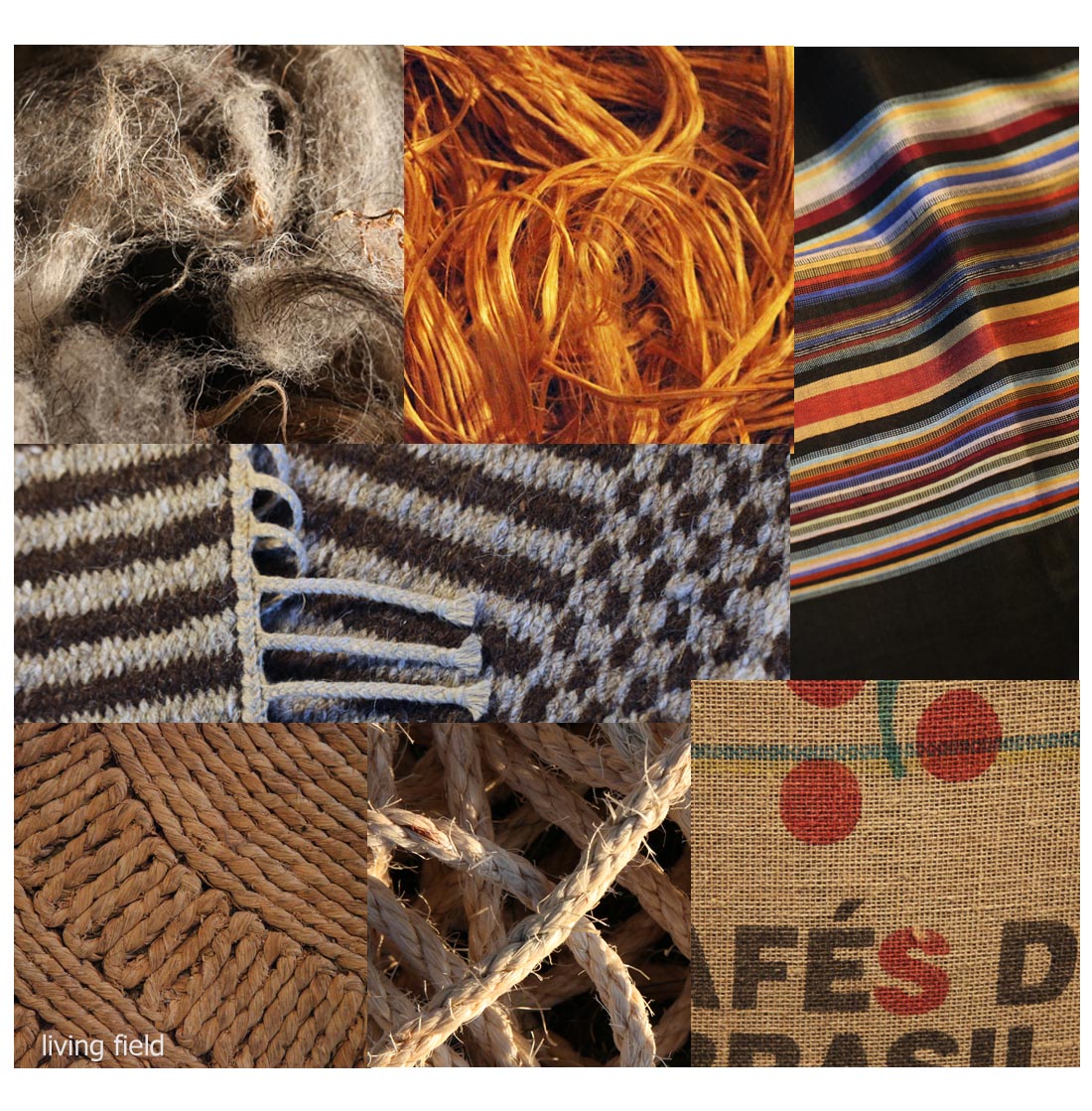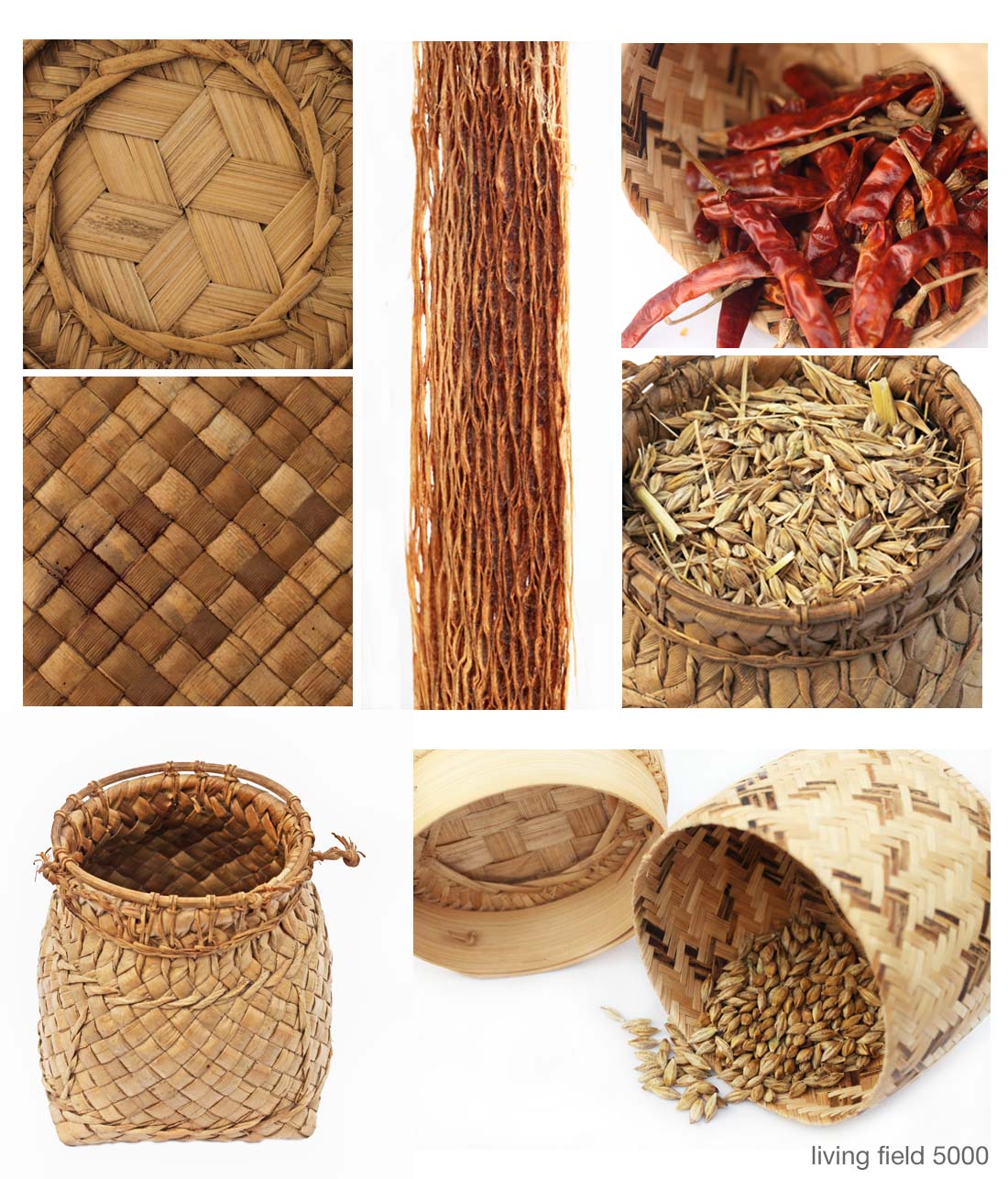People look to the plant world first for food and drink, and then for materials to clothe and shelter them and to form twine and cord for binding things and baskets for holding grain and fruit. These materials were sometimes whole leaves, stems or roots, laid like thatch, or plaited; and sometime fibres taken out of plants and then spun and woven. People also found ways to turn parts of animals into fabrics – silk from insect cocoons, wool from sheep.
Today, many of us take for granted things like denim jeans, a silk top, a woolen jute-backed carpet. But the use of natural fibres has a long and tortuous history. Here, we look at the natural, mainly plant, fibres and the industries based on them. And as for other crops, lack of home production and reliance on imports become main themes.

The fibres panel shows examples of raw and processed plant and animal fibres: from top left, clockwise – wool cast off by North Ronaldsay sheep, jute fibre at Verdant Works Dundee, fabric made of silk from Laos, jute sacking, sisal rope, section of African grass mat, and part of rug woven from North Ronaldsay sheep’s wool. All photographs Living Field collection.
The fibres pages at 5000 Years consist of the summary and introduction on this page and …
- Fibre species of the world – notes on their biology and uses
- Fibres in the Maritime Croplands – past, present, prospects
- Sources, references, links, contacts – and ideas for activities and visits
Plant fibres – summary
- The fibrous parts of plants, mostly in leaves, stems and roots, were used unprocessed as thatch, clothing and twine before agriculture began here in the croplands.
- Agriculture provided bulk sources of fibre with which the early farming people were able to make cloth, baskets, cord and thatch.
- Flax, to make linen cloth, has been the only major fibre crop grown here, but is no longer farmed commercially. Hemp and nettle have also been grown occasionally for craft-work and minor commercial production. Oat straw, heather and rushes have been used to make simmens, a type of rope used in thatching a house.
- Most of the world’s plant fibre crops – such as cotton and jute – are grown in warmer places than the north east Atlantic, except flax from the Baltic.
- Linen production based on homegrown and imported flax gave rise to major industries in east and central Scotland based on imported cotton and jute in the 1700s and 1800s.
- Plant fibres are now imported as raw or finished product for wide use in home and industry as clothing (e.g. cotton, denim, linen, silk, wool), floorcovering (carpet, matting, lino), insulation, particle board, sacking, canvas, rope and twine.
- The main fibre products grown locally now come, not from crops, but from plantation forestry and animals, mainly sheep. In recent years, cereal straw has been used for insulating buildings.
- Fibre crops have had only small lasting effects on the plants and ecology of the croplands – relic plants of the flax industry are rare, and while nettles are still very common, it is not because they were once used for cloth-making.
Introduction
Types of plant and animal fibre. The use of natural fibre. History of fibre in the croplands.
Many plants have stems and roots which are strong enough and pliable enough to be bent and twisted into various shapes without them breaking too easily or having to be altered or processed. Of this type are roofing thatch made from whole stems and leaves, baskets made from plaited stems and leaf blades, and twine and rope made from stems. Hunters and wild harvesters in the neolithic, much earlier than 5000 years ago, used such materials every day. The cloak worn by ‘the man in the ice’ when he died is made of plaited grass.
Even today, unprocessed plant material is used throughout the world to make thatch, shelters, baskets, clothing, rope and twine. Photographs below show small baskets made from plaited grass and stems and a strip of under-bark used as binding or strapping.
Unprocessed leaf and stem had their limitations, so people discovered plants containing fibres that could be extracted and made into objects that looked nothing like the original plant parts. These processed fibres give rise to materials of two broad types: those made by joining the fibres together into yarn which is woven to make textiles, for example from cotton, jute, hemp, flax, manila and nettle; and those made more simply by pulping the fibres and compressing them into felt, an advanced form of which is rayon made from certain types of wood, but which can be made from many types of fibre.
In addition to fibres from plants there are fibres spun from the hair of animals: sheep, horse and camelids such as the alpaca and lama and oxen such as the yak. The silkworm, the larva of a moth, nurtured on leaves of the mulberry (Morus species), encloses itself in a cocoon from which the silk is spun.
Fibres have a long history in the agriculture of the north east atlantic region. Sheep’s wool is the best known, but plant fibres from flax and hemp have both featured in agriculture at various times over the last few thousand years. Flax formed the base of local and industrial production, but the plants most important to recent industry (1700s and 1800s, fading in the early 1900s) have been jute and cotton, neither grown here. Their influence has been through manufacturing.
Continued …. Fibres in the Croplands

Baskets made from plaited grass, for holding gathered grain and fruit, have been in daily use for many thousands of years.Those above are from south-east Asia (photographs Squire / Living Field), one used in the forest, the other made as craft work for sale. The grain was grown in the Living Field garden, the chillies in a Perthshire greenhouse. The shoulder strap, upper middle, about 2 cm wide, from the same region, is whole, not plaited (species unknown).
